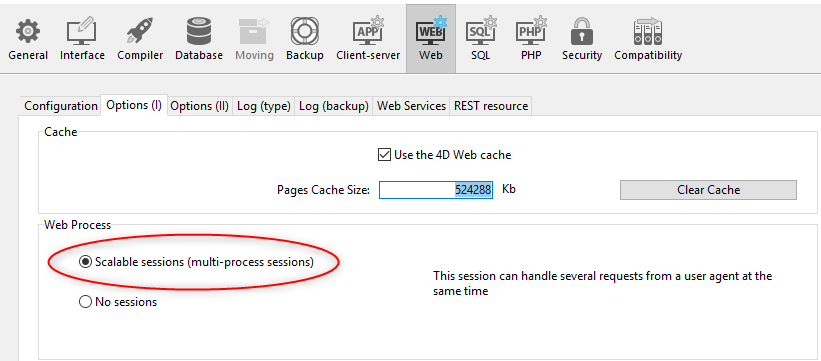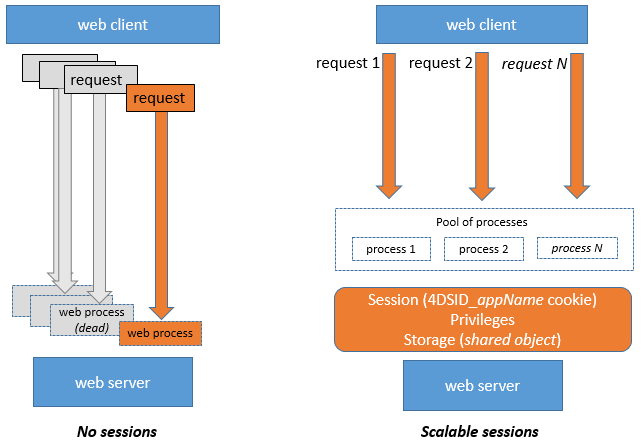Sessões usuário
O servidor web 4D oferece recursos integrados para gerenciar sessões usuário. A criação e manutenção de sessões de usuários permite que você controle e melhore a experiência do usuário em sua aplicação web. Quando as sessões de usuários são ativadas, os clientes web podem reutilizar o mesmo contexto de servidor de uma requisição para outra.
As sessões de usuário do servidor Web permitem:
- manipular várias solicitações simultaneamente do mesmo cliente web através de um número ilimitado de processos preventivos (sessões servidor web são escaláveis),
- partilhar dados entre os processos de um cliente Web,
- associar privilégios a sessões de usuário,
- manipula o acesso através de um objeto
Sessione a Session API.
Nota: a implementação atual é apenas o primeiro passo de uma funcionalidade abrangente futura, permitindo aos desenvolvedores gerenciar permissões usuário hierárquicos através de sessões em todo da aplicação web.
Activação de sessões
A funcionalidade de gerenciamento de sessão pode ser ativado e desativado no seu servidor web 4D. Existem diferentes formas de ativar a gestão de sessões:
- Usando a opção sessões escalonáveis na página "Web/Opções (I)" das Configurações (parâmetro permanente):

Esta opção é selecionada por defeito nos novos projetos. No entanto, ele pode ser desativado selecionando a opção Não sessões, onde os recursos da sessão web estão desativados (nenhum objeto Session está disponível).
- Usando a propriedade
.chamableSessiondo objeto Web Server (para passar no parâmetro settings da função.start()). Neste caso, este parâmetro substitui a opção definida na caixa de diálogo Propriedades para o objeto Web Server (não é armazenado em disco).
O comando
WEB SET OPTIONtambém pode definir o modo de sessão para o servidor Web principal.
Em qualquer caso, o parâmetro é local para a máquina; para poder diferir no servidor Web 4D Server e os servidores Web de máquinas 4D remotas.
Compatibilidade: uma opção Sessões herdadas está disponível em projetos criados com uma versão 4D anterior a 4D v18 R6 (para mais informações, por favor, consulte a documentação do site web doc.4d.com).
Session implementation
Quando as sessões são ativadas, mecanismos automáticos são implementados, com base em um cookie privado definido pelo próprio 4D: "4DSID_AppName", onde AppName é o nome do projeto da aplicação. Este cookie faz referência à sessão web atual da aplicação.
O nome do cookie pode ser usado pela propriedade
.sessionCookieName.
-
Em cada solicitação de cliente web, o servidor web verifica a presença e o valor do cookie privado "4DSID_AppName".
-
Se o cookie tiver um valor, 4D procura pela sessão que criou este cookie entre as sessões existentes; Se esta sessão for encontrada, ela será reutilizada para a chamada.
-
Se a solicitação do cliente não corresponder a uma sessão já aberta:
- uma nova sessão com um cookie "4DSID_AppName" é criado no servidor da web
- um novo objeto
Sessionfoi criado sendo dedicado à sessão web escalável.
O objeto Session atual pode ser acessado através do comando Session no código de qualquer processo web.

Os processos Web geralmente não terminam, eles são reciclados em um pool para aumentar a eficiência. Quando um processo termina de executar uma solicitação, ele é colocado de novo no pool e disponibilizado para a próxima solicitação. Dado que um processo web pode ser reutilizado por qualquer sessão, variáveis processo devem ser limpas pelo seu código no final de sua execução (usando CLEAR VARIABLE, por exemplo). Esta limpeza é necessária para todas as informações relacionadas ao processo, como uma referência a um arquivo aberto. Esta é a razão porque é recomendado usar o objeto Session quando você deseja manter informações relacionadas à sessão.
Partilhar informações
Cada objeto Session fornece uma propriedade .storage que é um objeto compartilhado. Essa propriedade permite que você compartilhe informações entre todos os processos manipulados pela sessão.
Duração da sessão
Uma sessão Web escalável é encerrada quando:
- o servidor web está parado,
- o tempo limite do cookie de sessão foi atingido.
O tempo de vida de um cookie inativo é 60 minutos por padrão, o que significa que o servidor irá automaticamente fechar as sessões inativas após 60 minutos.
Este tempo limite pode ser definido usando a propriedade .idleTimeout do objeto Session (o tempo limite não pode ser inferior a 60 minutos).
Quando uma sessão web escalável é fechada, se o comando Session for chamado depois:
- o objeto
Sessãonão contém privilégios (é uma sessão de convidado) - a propriedade
.storageestá vazia - um novo cookie de sessão é associado à sessão
Privilégios
Os privilégios podem ser associados a sessões. No servidor web, você pode fornecer acesso ou recursos específicos, dependendo dos privilégios da sessão.
Você pode atribuir privilégios usando a função .setPrivileges(). Em seu código, você pode verificar os privilégios da sessão para permitir ou negar acesso usando a função .hasPrivilege(). Por padrão, as novas sessões não têm nenhum privilégio: elas são sessões guest (a função .isGuest() retorna true).
Na implementação atual (v18 R6), apenas o privilégio "WebAdmin" está disponível.
Exemplo:
If (Session.hasPrivilege("WebAdmin"))
//Access is granted, do nothing Else
//Display an authentication page End if
Exemplo
Em uma aplicação CRM, cada vendedor gerencia seu próprio portefólio de clientes. A datastore contém pelo menos dois dataclasses ligados: Customers e SalesPersons (um vendedor tem vários clientes).

Queremos que um vendedor autentique, abra uma sessão no servidor web e que os 3 primeiros clientes sejam carregados na sessão.
- Executamos este URL para abrir uma sessão:
http://localhost:8044/authenticate.shtml
Em um ambiente de produção, é necessário usar uma conexão HTTPS para evitar qualquer informação não criptografada que circule na rede.
- A página
authenticate.shtmlé um formulário que contém os campos de entrada userId et password e enviando uma ação 4DACTION POST:
<!DOCTYPE html>
<html>
<body bgcolor="#ffffff">
<FORM ACTION="/4DACTION/authenticate" METHOD=POST>
UserId: <INPUT TYPE=TEXT NAME=userId VALUE=""><br/>
Password: <INPUT TYPE=TEXT NAME=password VALUE=""><br/>
<INPUT TYPE=SUBMIT NAME=OK VALUE="Log In">
</FORM>
</body>
</html>
- O método projeto de autenticação procura para a pessoa userID e valida a senha contra o valor de hash já armazenado na tabela SalesPersons:
var $indexUserId; $indexPassword; $userId : Integer
var $password : Text
var $userTop3; $sales; $info : Object ARRAY TEXT($anames; 0)
ARRAY TEXT($avalues; 0) WEB GET VARIABLES($anames; $avalues)
$indexUserId:=Find in array($anames; "userId")
$userId:=Num($avalues{$indexUserId})
$indexPassword:=Find in array($anames; "password")
$password:=$avalues{$indexPassword}
$sales:=ds. SalesPersons.query("userId = :1"; $userId).first() If ($sales#Null)
If (Verify password hash($password; $sales.password))
$info:=New object()
$info.userName:=$sales.firstname+" "+$sales.lastname
Session.setPrivileges($info)
Use (Session.storage)
If (Session.storage.myTop3=Null)
$userTop3:=$sales.customers.orderBy("totalPurchase desc").slice(0; 3)
Session.storage.myTop3:=$userTop3
End if
End use
WEB SEND HTTP REDIRECT("/authenticationOK.shtml")
Else
WEB SEND TEXT("This password is wrong")
End if Else
WEB SEND TEXT("This userId is unknown")
End if